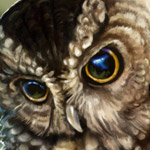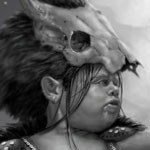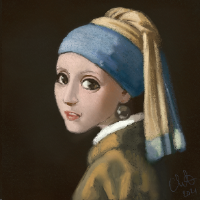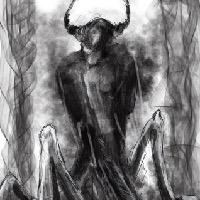





Are you trying to spew those lurker tentacles at us and failing or are you just in a state of constant amazement? 

The shoutbox is unavailable to non-members
Shoutbox History






Are you trying to spew those lurker tentacles at us and failing or are you just in a state of constant amazement? 

Basic Training Exercises
10 Aug 2014 16:17 #5059
by Charlotte
Any an all misspellings are henceforth blamed on the cats.
Basic Training Exercises was created by Charlotte
These are a selection of basic training which can be done with pen and paper but which may also be useful if you're new to using a tablet. The training listed here can be done every day and should be particularly useful if you're a beginner or intermediate level artist. Some of the exercises aim to help you see the thing you're drawing, some are aimed to improve eye-hand coordination or just plain old line quality. If you wish to share your results, we suggest you do so in your sketchbook or WIP thread.
Exercise #1
This exercise is so very basic that it’s tempting to skip it, but it does have its merits. Draw parallel lines and try to keep them the same width, shade and the same distance from each other. Practice both as straight lines as you can (horizontal, vertical, angled) and wavy or curved ones. Also practice drawing circles and try to get them as perfect as you can. To practice shading values you can make a row of small boxes (five or so) and make the first as dark as you can. Shade the last box as light as you can and then try to shade the remaining boxes to produce an even gradient.
I certainly need to practice lines and circles!
Exercise #2
This exercise is from Henning Ludvigsen’s website : with pen and paper, draw the outline of objects without looking down at your drawing until you’re finished. The two ends of your line probably won’t meet up but your eye hand coordination will improve with practice.
As you all can see, this is a brass encanter... (with a small sketch to show it more accurately, to the right!)
Exercise #3
This exercise is from “Drawing on the Right Side of the Brain” by Betty Edwards: draw the contour of a face from imagination on one side (left or right) of a paper and then draw two straight horizontal lines at top and bottom. Then draw the mirror image of the face on the other side. This forces you to look at the shape of the line. To make it more difficult, draw the contour of a monster or otherwise complex creature. The result in either case would be one of those "faces or vase" images.
Ok, this didn't end up at all symmetrical... and I think it might be even more efficient if you found someone to trade profiles with! Collaborate, and finish each others "vases".
Exercise #4
Another exercise from “Drawing on the Right Side of the Brain” is to turn an image upside down and then try to copy it. This will help you draw what you actually see rather than revert to what you “know” is there.
My attempt at drawing a chinese dragon upside down (and the result turned right way up). I admit I was lazy with shading and scales, and I suspect eyes and claws would have turned out better if I'd seen them the right way up BUT, it's a useful exercise if you try it with something you might have a preconcieved idea of.
BUT, it's a useful exercise if you try it with something you might have a preconcieved idea of.
Exercise #5
Draw from life! Take a sketchpad, a couple of pencils and maybe a kneadable eraser with you (and something comfortable to sit on, if needed) and go to the nearest park/zoo/forest/town square and do some sketches. (And if it’s raining you can stay at home and do still life studies of kitchen bowls instead.)
Exercise #6
Practice anatomy and gestures by doing quick sketches with the aid of such sites as Posemaniacs , Quickposes and Pixelovely . You can often choose times, full body, hands or feet, male or female etc. Just remember to do several – if you have 30 minutes do 30-60 poses in that time rather than letting one pose get your full attention.
Exercise #1
This exercise is so very basic that it’s tempting to skip it, but it does have its merits. Draw parallel lines and try to keep them the same width, shade and the same distance from each other. Practice both as straight lines as you can (horizontal, vertical, angled) and wavy or curved ones. Also practice drawing circles and try to get them as perfect as you can. To practice shading values you can make a row of small boxes (five or so) and make the first as dark as you can. Shade the last box as light as you can and then try to shade the remaining boxes to produce an even gradient.
I certainly need to practice lines and circles!
Exercise #2
This exercise is from Henning Ludvigsen’s website : with pen and paper, draw the outline of objects without looking down at your drawing until you’re finished. The two ends of your line probably won’t meet up but your eye hand coordination will improve with practice.
As you all can see, this is a brass encanter... (with a small sketch to show it more accurately, to the right!)
Exercise #3
This exercise is from “Drawing on the Right Side of the Brain” by Betty Edwards: draw the contour of a face from imagination on one side (left or right) of a paper and then draw two straight horizontal lines at top and bottom. Then draw the mirror image of the face on the other side. This forces you to look at the shape of the line. To make it more difficult, draw the contour of a monster or otherwise complex creature. The result in either case would be one of those "faces or vase" images.
Ok, this didn't end up at all symmetrical... and I think it might be even more efficient if you found someone to trade profiles with! Collaborate, and finish each others "vases".
Exercise #4
Another exercise from “Drawing on the Right Side of the Brain” is to turn an image upside down and then try to copy it. This will help you draw what you actually see rather than revert to what you “know” is there.
My attempt at drawing a chinese dragon upside down (and the result turned right way up). I admit I was lazy with shading and scales, and I suspect eyes and claws would have turned out better if I'd seen them the right way up
Exercise #5
Draw from life! Take a sketchpad, a couple of pencils and maybe a kneadable eraser with you (and something comfortable to sit on, if needed) and go to the nearest park/zoo/forest/town square and do some sketches. (And if it’s raining you can stay at home and do still life studies of kitchen bowls instead.)
Exercise #6
Practice anatomy and gestures by doing quick sketches with the aid of such sites as Posemaniacs , Quickposes and Pixelovely . You can often choose times, full body, hands or feet, male or female etc. Just remember to do several – if you have 30 minutes do 30-60 poses in that time rather than letting one pose get your full attention.
Any an all misspellings are henceforth blamed on the cats.
The topic has been locked.
Latest Activity
Banj updated their profile picture


Charlotte Still wearing a mask? Is it so we won't see you hoarding food in those cheeks of yours?
See More

Banj Mfmuh Guhmfpf
See More

Charlotte I'll take that as a yes...
See More

Charlotte Why is there a tiny flashing thing in front of the reply link/button? It's so small I can't see if it's an exclamation mark or a question mark... or...both?)
See More

Banj Because? Both!
See More

Charlotte *gasp*
See More
CaptainDeth updated their profile picture

CaptainDeth Ahoy folks, just a newbie here, just getting started. Thanks for allowing me in.
CaptainDeth Thank You
CaptainDeth and Mr.Bungle joined the site
honbasic joined the site
Gawk joined the site














